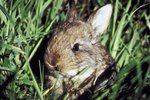Things You'll Need
Kitten milk replacer
3 cc syringe
Teat cannula
Towels
Cotton balls
Warm water
Box
Acidophilus
Plain alfalfa pellets
Oat hay
Timothy hay
Feeding dish
Shallow water dish
Carrier
Hay
Banana
Apple
Knife
Whole oats
Teaspoon
Wild baby bunnies should not be handled by humans unless it is an absolute certainty that they are orphaned or abandoned. If they are removed from a nest, the babies will require care from knowledgeable professionals. Immediately contact a wildlife rehabilitator or a veterinarian who specializes in rabbit care to maximize their chances of survival. Mother rabbits typically nurse their young once in the middle of the night. Bunnies that are not properly fed by their mothers will have sunken stomachs, and they will require human intervention to maintain regular feeding.
Prepare the kitten milk replacer, or KMR, according to the directions on the back panel of the can. Add a pinch of acidophilus to the formula. Fill the syringe with the formula by pulling up on the plunger. Attach the teat cannula to the syringe tip according to manufacturer’s directions.
Feed newborns who have not opened their eyes twice daily at 2- to 2 1/2-cc increments. Rabbits that are 1 to 2 weeks old generally require 5- to 7-cc feedings twice a day. Give 2- to 3-week-olds feedings of 7 to 13 cc twice a day.
Position the bunny so that it is sitting upright and direct the syringe down toward the side of the mouth, to prevent aspiration.
Stimulate the baby after feedings to help it urinate and defecate until its eyes open. Soak a cotton ball in warm water and stroke the anal area until you witness stool and urine production. Continue this action until the bunny finishes.
Create a nesting area with a box and towels. Cover the nest with additional towels to maintain darkness until the bunny opens its eyes.
Offer plain alfalfa pellets, along with oat and timothy hay, in the feeding tray after the bunny opens its eyes at 2 weeks of age. Fill the water tray with fresh water.
Feed 3- to 6-week-old bunnies amounts of 13 to 15 cc of KMR and begin reducing the daily feedings from twice to once gradually over this period to begin weaning.
Line a carrier with towels. Cover the towels with fresh hay. Cut up bananas or apples and combine with whole oats.Measure out 2 teaspoons and offer in place of the formula to wean.
Warnings
It is illegal in most states to take wild animals into your care; it should be done only as a last resort. The best course of action is to leave bunnies for the mother's eventual return. Contact a wildlife expert if there are obvious signs of injury, illness or malnourishment.
References
Photo Credits
-
Baby Bunny image by 6922Designer from Fotolia.com
Writer Bio
Lina Schofield began writing professionally in 2005. She is a professional freelance writer who has worked on a variety of projects, including the founding of the quarterly publication "Propaganda." Schofield also has been published in several student collections. She received her Bachelor of Arts in English at University of Wales Trinity Carmarthen.




